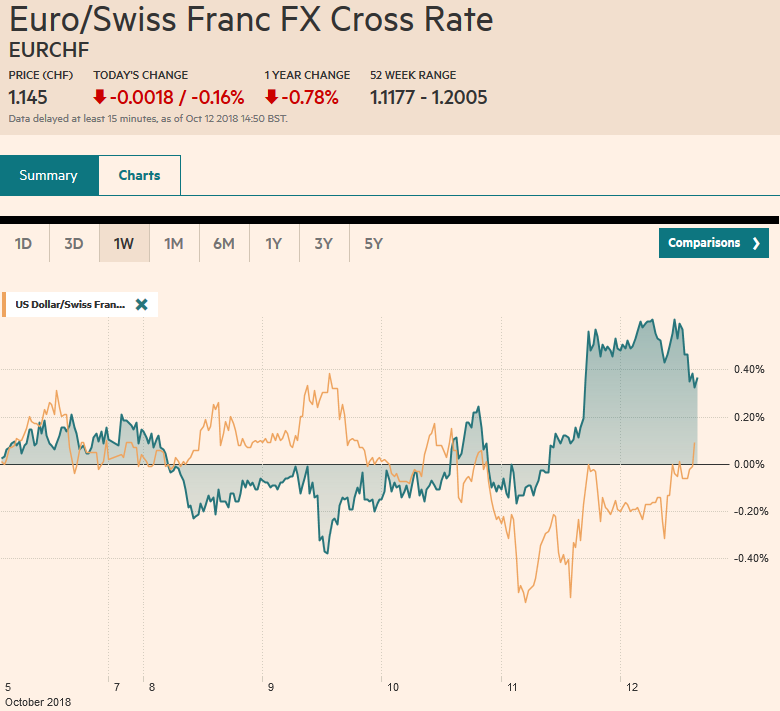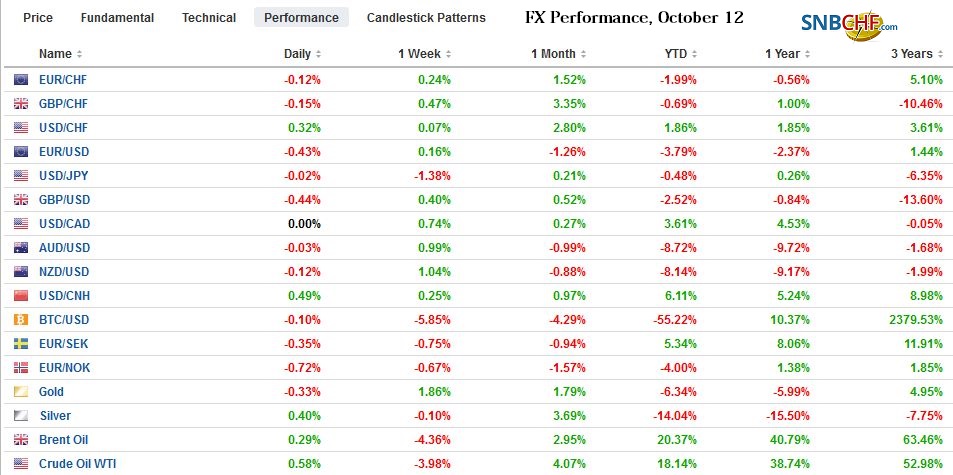Swiss Franc The Euro has fallen by 0.16% at 1.145 EUR/CHF and USD/CHF, October 12(see more posts on EUR/CHF, USD/CHF, ) Source: markets.ft.com - Click to enlarge FX Rates Overview: Equity markets are stabilizing today as Asian and European markets shrug off the failure to get traction in the US yesterday. As everything and nothing was behind the dramatic sell-off in recent days, the same could be said about today’s recovery. Most accounts seem to be emphasizing two developments: a report indicating that despite the talk earlier in the week, there is a recognition by the US Treasury staff that China’s actions do not reach the threshold of manipulation, and signs that the US tariffs were not having much impact on
Topics:
Marc Chandler considers the following as important: $INR, 4) FX Trends, AUD, CAD, EUR, Featured, FX Daily, GBP, JPY, newsletter, SPX, USD
This could be interesting, too:
Eamonn Sheridan writes CHF traders note – Two Swiss National Bank speakers due Thursday, November 21
Charles Hugh Smith writes How Do We Fix the Collapse of Quality?
Marc Chandler writes Sterling and Gilts Pressed Lower by Firmer CPI
Michael Lebowitz writes Trump Tariffs Are Inflationary Claim The Experts
Swiss FrancThe Euro has fallen by 0.16% at 1.145 |
EUR/CHF and USD/CHF, October 12(see more posts on EUR/CHF, USD/CHF, ) Source: markets.ft.com - Click to enlarge |
FX RatesOverview: Equity markets are stabilizing today as Asian and European markets shrug off the failure to get traction in the US yesterday. As everything and nothing was behind the dramatic sell-off in recent days, the same could be said about today’s recovery. Most accounts seem to be emphasizing two developments: a report indicating that despite the talk earlier in the week, there is a recognition by the US Treasury staff that China’s actions do not reach the threshold of manipulation, and signs that the US tariffs were not having much impact on Chinese trade through last month. Bond markets are narrowly mixed, and although both chambers of Italy’s parliament approved the fiscal outline, the bond market is firmer, and premium over Germany has narrowed by a few basis points. The US 10-year yield is firmer, but at 3.16% it is still off six basis points on the week and if sustained could be the first rise in the rate this week. Oil prices are firmer after falling around 5.5% over the past two sessions. The Norwegian krone and Canadian dollar are exceptions to the US dollar’s firmer today against most of the major currencies. Among emerging market currencies, the Chinese yuan eased, but Asian currencies generally moved higher, led by Korea and Taiwan. The South African rand is also gaining ahead of Moody’s credit review later today (currently Baa3 with stable outlook). The Singapore dollar eased slightly even though the Monetary Authority tightened policy for the second time this year (only two meetings a year). |
FX Performance, October 12 |
China reported a $31.7 bln September trade surplus. The median forecast in the Bloomberg survey was for a $19.2 bln surplus after a $26.65 bln surplus in August (which represents a small revision from the initial estimate). The larger than expected surplus was a function of both stronger exports and slower imports. Of note, crude oil imports fell by 3%, copper ore imports were record levels, while iron ore imports rose almost 5%. Soy imports fell 12%. Aluminum exports fell 2.5%. Many are reading the strong trade data as China’s resilience in the face of the first round of US tariffs (on $50 bln of Chinese goods). The second round (10% on $200 bln of Chinese goods) did not go into effect until late September (September 24th). We suggest drawing more tentative conclusions from the trade data as there was likely some increased activity to beat the tariffs from both Chinese producer side as well as the American importers, as this appears to be reflected in the US inventory data.
Among market participants, it seemed clear that however, China was managing the yuan, it did not reach the definition of manipulation for trade advantage. Earlier in the week, the Trump Administration seemed to have been possibly testing the waters to cite China as a manipulator in the semi-annual report expected next week. It thought to be part of the multifaceted pressure the US is trying to bring to bear on China. However, the pushback, like on some elements of NAFTA2.0, appears to have been strong enough to force the administration to reconsider. In fact, the US appears have swung the other way, and reports suggest it has signaled a willingness for a bilateral meeting between Trump and Xi at the G20 summit at the end of next month, even though China has not made any fresh concessions.
The euro initially extended yesterday’s gains and made a high of $1.1610 in Asia. Last week’s high was closer to $1.1630. It eased back to around $1.1575 in the European morning and if the $1.1550 holds (where a 1.1 bln euro expiring option is struck), the euro may retest the highs in North America. An option for 884 mln euros at $1.1590 is also set to be cut today. While the Italian parliament vote in favor of the fiscal framework is another step toward the coming confrontation with the EU, today investors are not as focused on it. Italian bonds and stocks are among the best performers in Europe today. The EMU did surprise with a stronger-than-expected 1% rise in August industrial output. The Bloomberg median forecast called for a gain half as much after Germany reported an unexpected 0.3% contraction. Separately, Bavaria goes to the polls this weekend, and it looks likely that the CSU loses its majority. The SPD, however, cannot take advantage of it. The Greens rather than the AfD appear to be moving into the vacuum.
As the UK-EU deal on Brexit appears to be drawing close, domestic pressure is building on Prime Minister May. We argue that May cannot simultaneously please three stakeholders: the EU, the Conservative Party, and Parliament. With little success, May initially tried to present a united front. More recently, she has tried to get the EU’s support, and this has required compromises that alienate the other stakeholders–a true trilemma. The DUP, which May relies on to secure a majority in Parliament rejects the EU’s backstop plan for the border and reports warn that some cabinet resignations are possible after May accepted the EU demand of no time limit on May’s own backstop. Sterling made a high near $1.3260 in early European turnover, a level it has not seen since the third week in September. However, the three-day advance is under threat now. The euro is firmer against sterling for the second consecutive session.
The dollar’s six-day slide against the yen may end today. On the run, the dollar lost nearly 2.5%, falling from about JPY114.55, the high for the year recorded on October 4 to almost JPY111.80 yesterday. The Nikkei gapped lower but rallied to close the gap and close higher on the day. The BOJ did not announce changes in its bond-buying program and the dollar. The dollar recovered to JPY112.50 today, but the nearly $500 mln JPY113.00 option that is expiring today is too far away to be impactful.
The dollar-bloc currencies are little changed. The Reserve Bank of Australia warned that the trade tensions could weigh on the Australian economy. The Australian dollar has been confined to a narrow range above $0.7100. It is up about 1% on the week. The Canadian dollar is the poorest performer among the majors this week, losing about 0.6%. The weakness in oil and some Canadian crude sells at a $50 discount to WTI and reports suggest China, in particular, is keenly interested, and equities are the likely culprits. Note that late this month (October 25) Canada’s 25% tariffs on seven types of steel imports as safeguards to avoid the diversion from the US to it.
With US stocks off six-days in a row coming into today, many investors just want the weekend to begin. The economic calendar is light, featuring import/export price indices and the University of Michigan Consumer Confidence survey. Neither are typically market movers. Perhaps the most interesting part of the confidence survey is the inflation expectations. The 5-10 year expectations have been between 2.4% and 2.6% since early last year. It was in the middle of the range in September. The Fed’s Evans and Bostic speak during the session. Three large US banks report earnings today. In the US morning, India will report CPI and industrial production. The former is expected to rise through 4.0% in September (from 3.7%), and the latter probably slowed to around 3.8% (from 6.6% in July). The S&P 500 is nearly 1% higher in electronic trading. Sustaining gains, unlikely yesterday, would help sentiment, and with a close above the 200-day moving average (~2765) could spur follow-through buying next week.
Graphs and additional information on Swiss Franc by the snbchf team.
Tags: #GBP,#USD,$AUD,$CAD,$EUR,$INR,$JPY,Featured,FX Daily,newsletter,SPX

